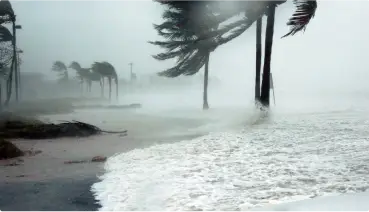In this project, we sought to understand which threats and situations American men and women find most alarming, analyzing the particular concerns of each gender. To do so, we surveyed over 1,000 individuals about a range of scenarios in which they might feel fear in an effort to gauge how men and women perceive potential perils. Additionally, our data reveal how people elect to protect and defend themselves, from taking age-old precautions to using novel technology to stay safe. To truly understand how various fears can affect the American public, keep reading.
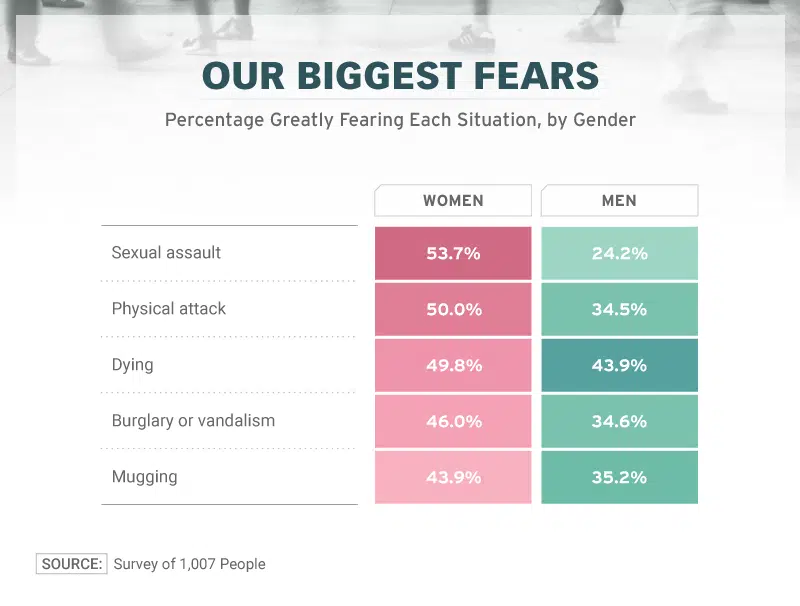
Terror's Top Causes
Regarding a range of physical threats, women were more likely to express “great fear” than their male counterparts. The largest disparity emerged around sexual violence: While the majority of women greatly feared being sexually assaulted, less than a quarter of men said the same. This difference is likely reflective of the rates at which women and men experience sexual assault. According to one recent study, 27 percent of women and 7 percent of men reported being attacked in this manner – and the gap is even wider for other forms of sexual misconduct, such as unwanted touching.
Other violence seemed to inspire roughly equal levels of dread in male respondents: Slightly more than a third of men said they greatly feared getting physically attacked, mugged, or having their homes burglarized. Conversely, women found the prospect of a physical attack more alarming than either a burglary or mugging. The fear that male and female respondents assessed most similarly was dying, with nearly 50 percent of women and 44 percent of men saying it frightened them greatly. While anxiety about the end of one’s life is only natural, psychologists suggest this fear can cause deep emotional distress and even lead to self-destructive thoughts and behaviors.
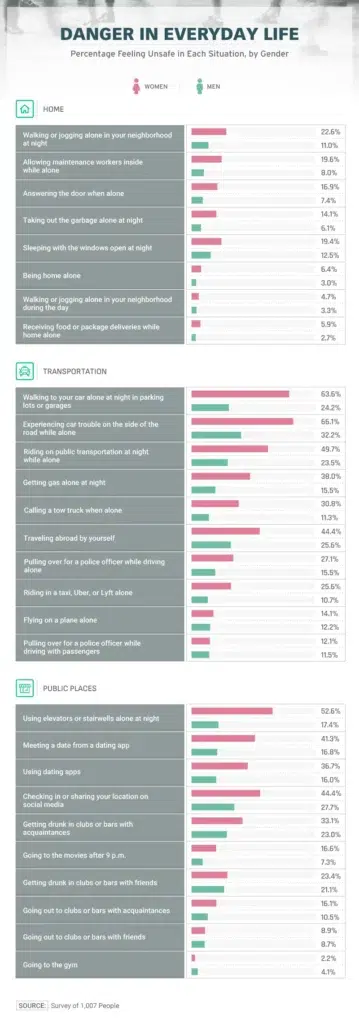
Scary Scenarios: Experiences by Sex
If fears of death and physical harm loom large for many individuals, which scenarios cause these fears to arise? For women and men alike, situations involving travel and transportation were particularly wrought with fear: Sixty-six percent of female respondents said they felt very unsafe when alone and experiencing car trouble on the side of the road, for example, as did nearly a third of men. Walking alone in a parking garage at night prompted nearly as much fear, as did other situations in which isolation could pose an issue. Roughly half of women said they felt unsafe using stairs or elevators in public places at night or riding public transportation by themselves in the evening.
Unfortunately, the feeling of being vulnerable to attack didn’t seem to lift once women got closer to home. Over a fifth of female respondents said they’d feel very unsafe walking or jogging in their own neighborhoods at night. Indeed, some researchers suggest this dynamic explains gaps in physical activity among genders: Women are less likely to exercise or run errands on foot because they feel harassed or at risk. A significant portion of female respondents even felt threatened inside their home. Roughly 20 percent said they felt very unsafe sleeping with the windows open or allowing maintenance workers inside when home alone.
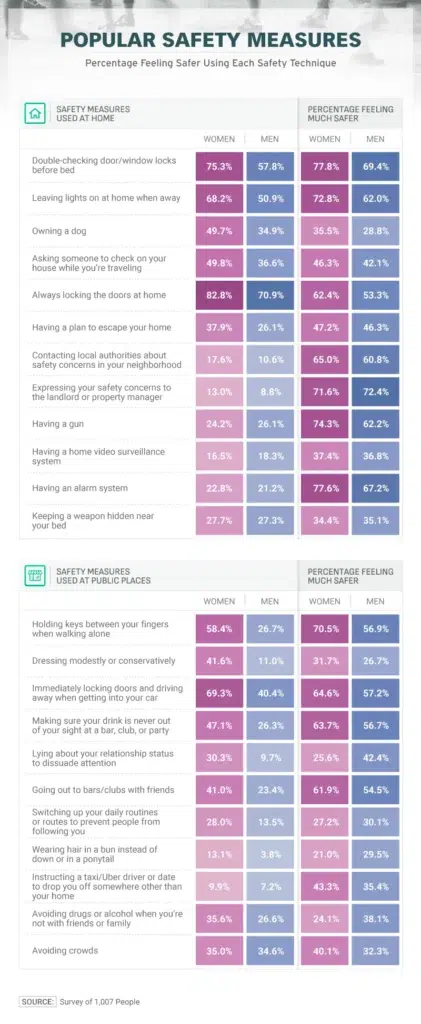
Popular Precautions
In response to fears that arise at home or in public settings, our respondents practiced a number of precautions. At home, the most popular methods among men and women involved keeping doors and windows locked at all times and doubling-checking them before bed. Some entrusted a canine to protect them at home: Half of women and a third of men owned a dog for this purpose, and a fair number reported doing so made them feel significantly safer. Getting a gun was a less common choice, but the majority of those who did reported feeling much safer with a firearm at home. Indeed, recent research suggests the desire for protection is the primary driver of guns sales in America.
With regard to protecting themselves in public, women were more likely than men to employ virtually every tactic included in our survey. Some of the notable differences involved preparing for a physical attack (women were more than twice as likely to hold their keys between their fingers when walking alone), but many others involved safety concerns related to going out. Forty-seven percent of women reported never letting their drinks out of their sight, and 41 percent said they would never go out without friends in tow. Comparatively, only about 1 in 4 men said they took either of those precautions.
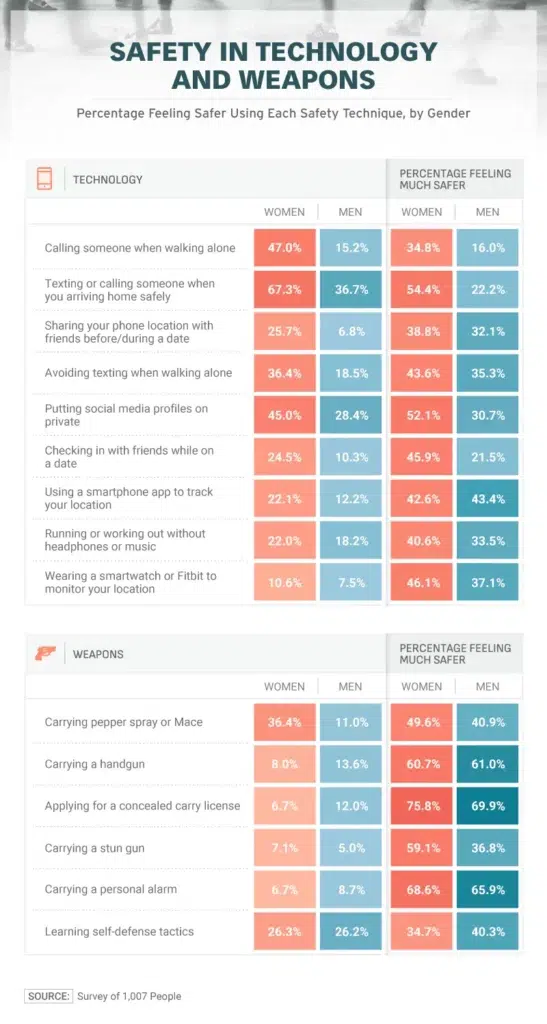
Protection Through Tech?
Women were also more likely than men to use technology to stay safe, especially to keep friends aware of their locations. More than two-thirds of women reported texting or calling someone to report they’d arrived home safely, and nearly 37 percent of men said they did the same. Additionally, 47 percent of female respondents said they called someone when walking alone, a precaution taken by just 15 percent of men. Experts discourage some forms of communication, however: The distraction of answering a text might leave you vulnerable to a sudden attack. Many seem to be aware of this risk, as 36 percent of women and 19 percent of men avoided texting while walking alone.
Additionally, some respondents opted to take protection measures beyond simply gripping their keys between their fingers. Men and women were equally likely to report learning self-defense tactics, although men were more likely to carry a handgun and apply for a concealed carry license. Women, conversely, were far more likely to carry mace or pepper spray. Self-defense experts, however, urge caution when using these weapons: While they do help many women escape attackers, they can sometimes backfire in windy conditions, disabling those who deploy them.
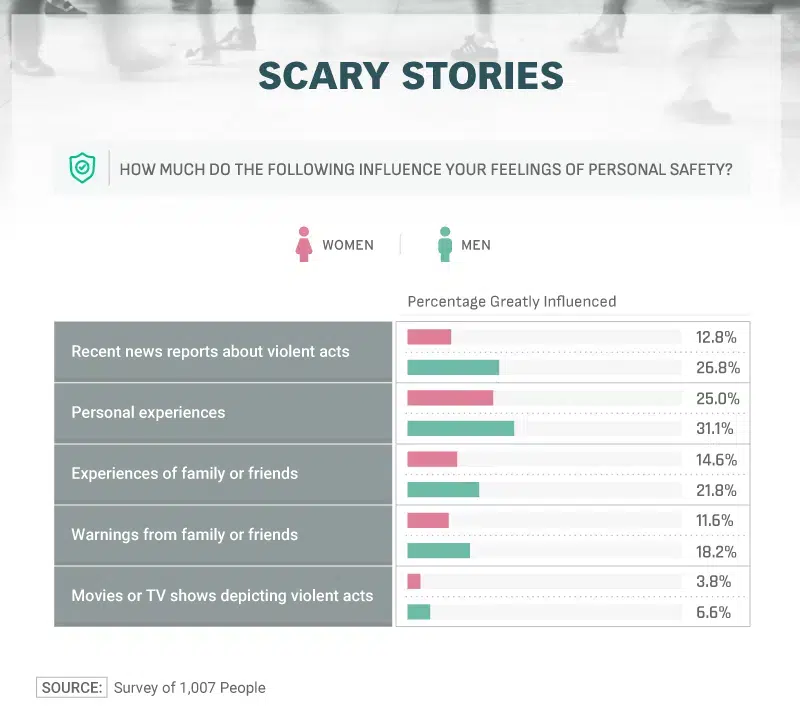
Forming Fears: Influences and Experiences
If fears of violence frequently cross our mind and inform our actions, where do they originate? Nearly 13 percent of women stated that news reports influenced their sense of safety, and roughly 27 percent of men said coverage of violent acts contributed to their fears. This dynamic may reflect news outlets’ tendencies to present gory stories that grip us: The “if it bleeds, it leads” ethos means we are frequently inundated with grim information. Fictional media can also inspire dread, of course, but for fewer people: violent movies and TV shows influenced fears among 3.8 percent of women and 6.6 percent of men.
Many female respondents reported being greatly affected by their own past experiences: exactly 25 percent of women said past events influenced how safe they felt in the present. About 31 percent of men said the same, making this the most influential source of information on people’s sense of safety.
Some men and women were also influenced by the experiences of those in their personal networks: 14.6 percent of women and 21.8 percent of men said their feelings of safety were impacted by the experiences of family or friends.
In the Words of Women
The results of our study showed that women were more likely than men to feel unsafe in many situations and that they were more likely to employ most of the safety techniques included in the survey. Women disproportionately experience these concerns – and the hard data sadly justify their apprehension.
We asked women what other actions they took to increase their feelings of personal safety, and their answers covered many aspects of their lives, from whom they married to how they applied their makeup. Flip through the slideshow to see what else women feel they must do to be safe at home and away.
When some of life’s simplest activities, such as going out after dark or walking down the street, provoke fear for so many, it seems incumbent on everyone to cast off complacency. We can begin by recognizing and responding to the fears both women and men feel, whether in public or within their own homes.
From Anxiety to Empowerment
The results of this project suggest our digital age creates additional anxieties: From ride-sharing services to dating apps and social media, the tools that enable our lifestyles entail their own risks. Yet, the hazards Americans find most threatening are dangers earlier generations feared as well, from being attacked in poorly lit places to the prospect of a home invasion.
Of course, no degree of caution will ward off all dangers: However we prepare to ensure own safety, we’re unfortunately never entirely insulated from the actions of others. Laws have been passed that are designed to increase security and reduce the risk of assault. The owner or landlord of a property has a duty to maintain the property in reasonable condition, to keep it lighted, supervised, and free of criminals, and failure to do so is negligent. If you’ve been hurt, physically or otherwise, expert legal advice may be your best recourse.
At Farah & Farah, we are experienced in handling negligent security lawsuits in Florida and Georgia. While we can’t undo the pain you’ve already endured, our experienced team will stand by your side until you see justice done.
Methodology
Using the Amazon Mechanical Turk platform, we recruited 1,007 people living in the U.S. to participate in this study. There were no qualifying questions, and only those who failed an attention check were not able to participate. Our participants were between 18 and 77 years old, and the average age was 36.6. The standard deviation for age was 11.7. 513 participants were men, and 494 were women.
The data in the survey were weighted but not statistically tested. Weights were based on race, gender, state, and age using population figures from 2016 U.S. census projections.
Limitations
Since our survey relies solely on the memories and experiences of our participants, some information they reported might have been incomplete, exaggerated, or understated.
While we asked participants about how safe they felt in many situations, there were many additional situations our survey did not explore. We compiled our list through research and preliminary surveying. We also did not include every possible safety measure in our analysis.
For the safety measures we did include, there was a possibility of self-selection bias. For example, we only had information on the perceived effectiveness of guns from the people who had guns. Those who didn’t own guns may have felt they would be less safe if they did have a gun.
The findings in this study were not statistically tested.
Sources
- https://news.gallup.com/poll/221183/americans-fear-walking-alone-ties-year-low.aspx
- https://news.gallup.com/poll/221270/cybercrime-tops-americans-crime-worries.aspx
- https://news.gallup.com/poll/220634/four-americans-fear-victim-mass-shooting.aspx
- https://www.nsvrc.org/statistics
- https://www.npr.org/sections/thetwo-way/2018/02/21/587671849/a-new-survey-finds-eighty-percent-of-women-have-experienced-sexual-harassment
- https://www.psychologytoday.com/us/blog/the-human-experience/201805/death-anxiety
- https://www.theguardian.com/inequality/2017/oct/11/paying-to-stay-safe-why-women-dont-walk-as-much-as-men
- https://www.pewresearch.org/social-trends/2017/06/22/the-demographics-of-gun-ownership/psdt_2017-06-22-guns-01-07/
- https://www.nbcnews.com/better/health/seven-second-rule-how-avoid-being-seen-easy-target-ncna789226
- https://www.forbes.com/sites/kareanderson/2017/03/14/how-we-women-can-take-steps-to-protect-ourselves/#47b2281b7cc4
- https://observer.com/2017/02/us-crime-rate-down-prime-time-tv-dramas/
Fair Use Statement
Given the importance of the subjects discussed in this project, we ask that you consider sharing this content with your friends and followers for noncommercial distribution. Doing so might help someone empathize with the fears that others feel, or let those struggling privately know they’re not alone. If you do decide to use our images or information, simply link back to this page so that others can explore the project in its entirety.

